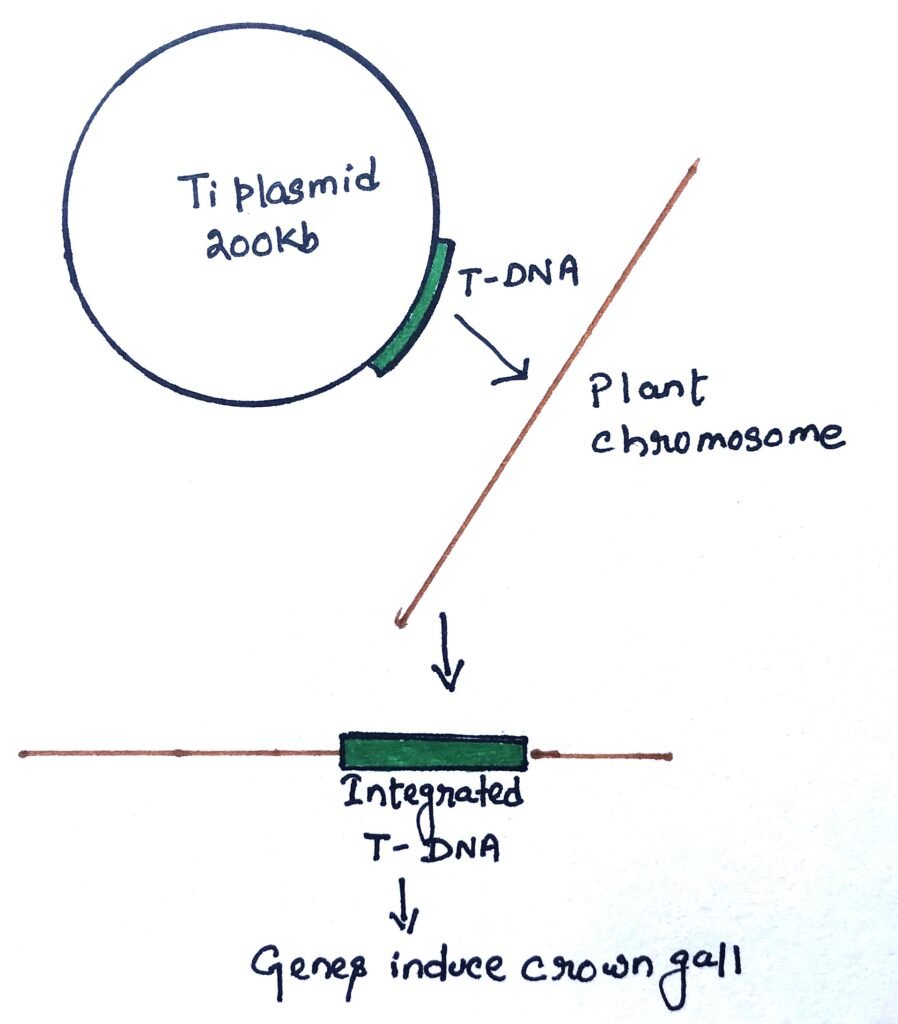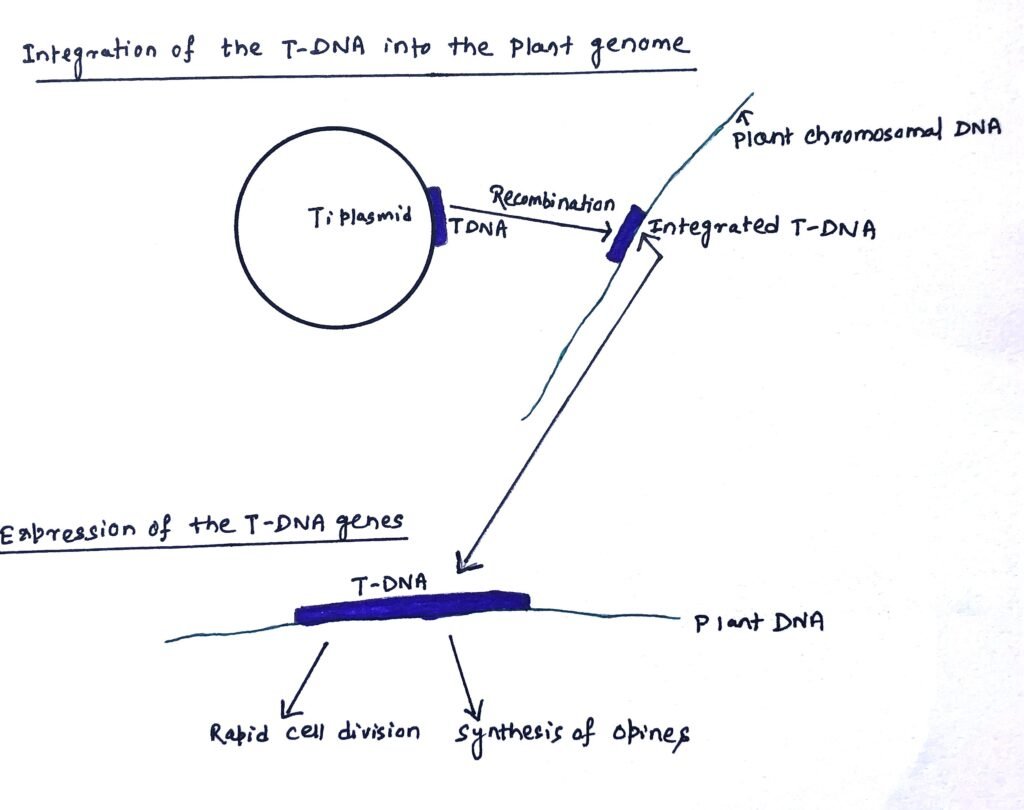In this article, I briefly describe cloning vectors for higher plants.
Cloning vectors
A small piece of DNA into which a foreign DNA fragment is inserted for cloning purposes is known as a cloning vector. The cloning vector may be the plasmid from a bacterium, a higher organism’s cell, or DNA taken from a virus. The vector contains restriction sites that help in the convenient insertion and removal of a DNA fragment. The cloning vector and the foreign DNA are treated with a restriction enzyme that creates the same overhang. Then, the fragments are ligated together. Genetically engineered plasmids and bacteriophages (such as phage λ) are perhaps most commonly used. Other types of cloning vectors are also used, which include bacterial artificial chromosomes (BACs) and yeast artificial chromosomes (YACs).
Cloning vectors for higher plants were developed in the 1980s, and it led to the production of genetically modified crops. Ti plasmid acts as a cloning vector in plants. Ti plasmid is a tumor-inducing plasmid of the bacteria Agrobacterium tumefaciens. The cells of the virulent strains of A. tumefaciens contain a small circular non-chromosomal DNA besides the chromosomal DNA. This small circular non-chromosomal DNA is called Ti plasmid, which carries genes affecting the pathogenicity and metabolism of opines.
Three types of vector systems have been used with varying degrees of success with higher plants
- Vectors based on naturally occurring plasmids of Agrobacterium tumefaciens.
- Direct gene transfer using DNA fragments not attached to a plant cloning vector.
- Vectors based on plant viruses.
Agrobacterium tumefaciens– Ti plasmid
The bacterium Agrobacterium tumefaciens is a gram-negative soil microorganism, which naturally transforms plant cells. It causes crown gall disease in many dicotyledonous plants. A wound on the stem allows A. tumefaciens to invade the plant, leading to the development of crown gall (figure 1). The bacteria infect and cause a cancerous proliferation of the stem tissue in the region of the crown. The ability to cause crown gall disease is associated with the presence of the Ti (tumour-inducing) plasmid within the bacterial cell. Ti plasmid (figure 2) is a large circular plasmid (greater than 200kb) that carries numerous genes involved in the infection process. Tumor formation is the result of the transfer, integration, and expression of genes on a specific segment of A.tumefaciens plasmid DNA, which is the T-DNA or transferred DNA. T-DNA resides on the Ti plasmid.

Agrobacterium, when grown above 28°C, loses its Ti plasmid and becomes avirulent, i.e. can’t induce crown galls. The T-DNA (figure 2) is the infection-causing part of the plasmid, which is between 15kb and 30kb in size, integrated into the plant chromosomal DNA.

It is maintained in a stable form in the plant cell and is passed on to daughter cells as an integral part of the chromosomes (figure 3). The T-DNA contains nearly eight genes that are expressed in the plant cell. These are also responsible for the cancerous properties of the transformed cells. These genes are also responsible for the synthesis of opines, which are used as nutrients for bacteria. A.tumefaciens genetically engineers the plant cell for its purposes.

Ti plasmid- Used for producing transformed plants
Generally, Ti plasmid infects plant cells and protoplasts. To isolate transformants, plant cells, and protoplasts can be plated onto a selective medium. The transformed cells will give rise to a mature plant, which will contain the cloned gene in every cell and will pass it to its offspring. Regeneration of a transformed plant will occur only if the Ti vector has been disarmed. Thus, the transformed cells do not display cancerous properties. It is possible to disarm the Ti vector as the cancer genes lie in the T-DNA, and are not needed for infection. Infection is mainly controlled by the virulence region of the Ti plasmid.
The parts of the T-DNA that are involved in infection are two 25 bp repeat sequences found at the left and right borders of the region integrated into the plant DNA. Any DNA placed between these two repeat sequences will be treated as T-DNA and transferred to the plant. Thus, it is possible to remove all the cancer genes from the normal T-DNA and replace them with an entirely new set of genes without disturbing the infection process.
The Ti vector-pBIN19
The binary vector pBIN19 is a disarmed cloning vector in which the left and right T-DNA borders flank a copy of the lacZ’ gene. The lacZ’ gene contains several cloning sites and a kanamycin resistance gene that functions after integration into the plant chromosome. Ti vectors such as pBIN19 have been supplemented by related vectors based on the Ri plasmid of Agrobacterium rhizogenes.
Some similarities exist between Ri plasmid and Ti plasmid. However, the transfer of the T-DNA from an Ri plasmid to a plant results in producing a hairy root disease instead of a crown gall. The hairy root disease is typified by a massive proliferation of a highly branched root system.
Conclusion
A small piece of DNA into which a foreign DNA fragment is inserted is known as a cloning vector. Cloning vectors for higher plants were developed in the 1980s, and it led to the production of genetically modified crops. Ti plasmid acts as a cloning vector in plants. Ti plasmid is a tumor-inducing plasmid of the bacteria Agrobacterium tumefaciens.
The bacterium Agrobacterium tumefaciens is a gram-negative soil microorganism, which naturally transforms plant cells. It causes crown gall disease in many dicotyledonous plants. The parts of the T-DNA that are involved in infection are two 25 bp repeat sequences found at the left and right borders of the region integrated into the plant DNA. Any DNA placed between these two repeat sequences will be treated as T-DNA and transferred to the plant.
The binary vector pBIN19 is a disarmed cloning vector in which the left and right T-DNA borders flank a copy of the lacZ’ gene. Ti vectors such as pBIN19 have been supplemented by related vectors based on the Ri plasmid of Agrobacterium rhizogenes.
You may also like:
- Cloning vectors based on bacteriophages and cosmids
- Yeast cloning vectors
- Animal viruses as cloning vectors

I, Swagatika Sahu (author of this website), have done my master’s in Biotechnology. I have around fourteen years of experience in writing and believe that writing is a great way to share knowledge. I hope the articles on the website will help users in enhancing their intellect in Biotechnology.



